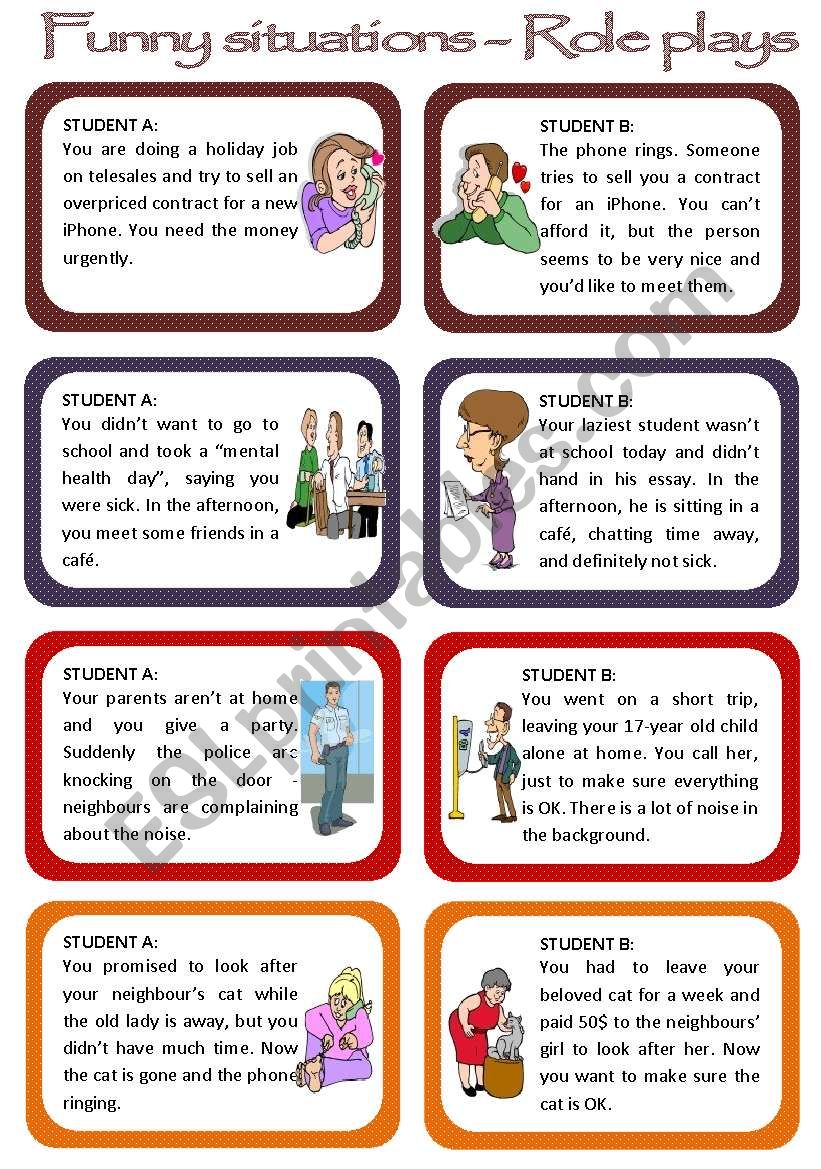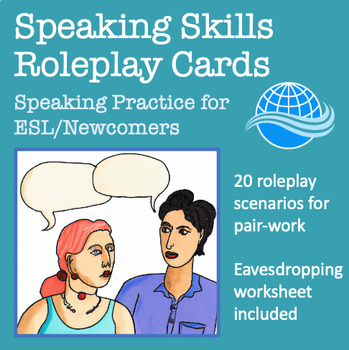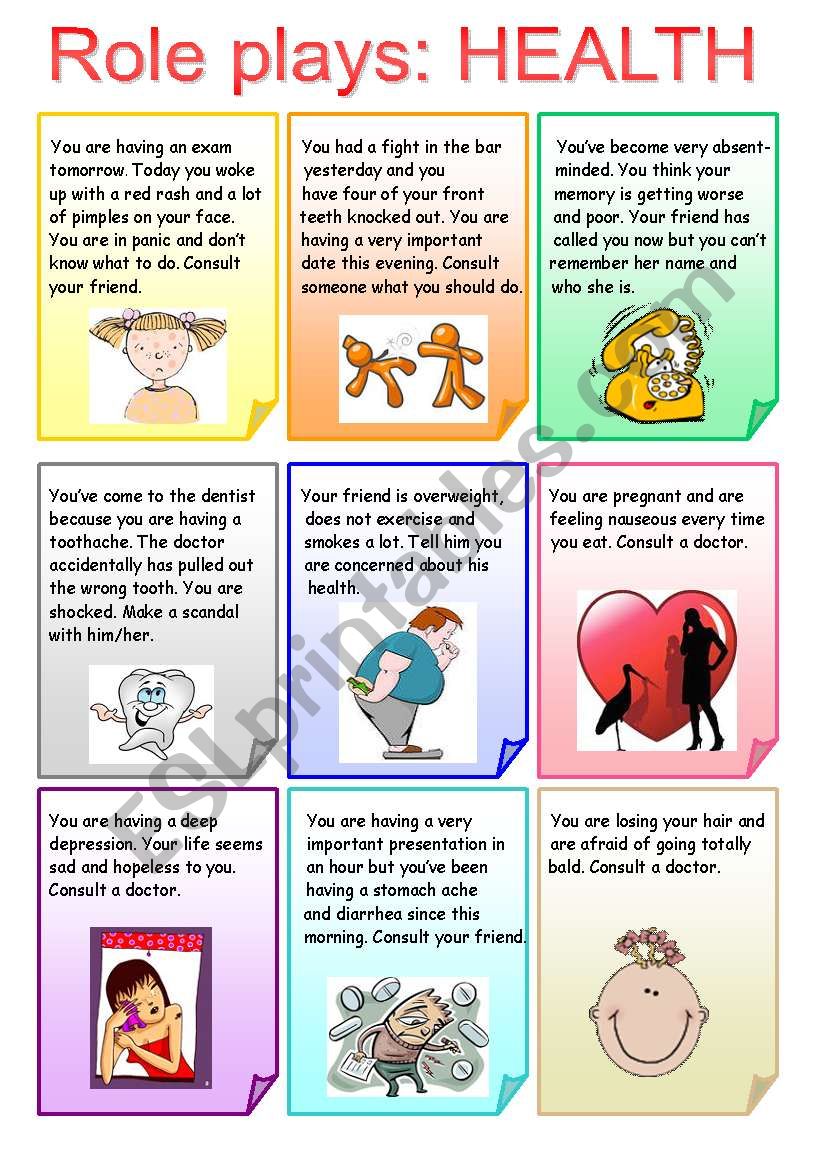
Role-play Scenarios for ESL Speaking Practice: A Comprehensive Guide
Learning a new language, especially English as a Second Language (ESL), presents a myriad of challenges. While grammar rules and vocabulary acquisition form the foundational pillars, the true test lies in the ability to communicate effectively and confidently in real-world situations. This is where speaking practice becomes paramount. Among the most dynamic and effective pedagogical tools available to educators and learners alike are role-play scenarios for ESL speaking practice. These simulated interactions provide a safe, engaging, and highly effective environment for learners to bridge the gap between theoretical knowledge and practical application, fostering fluency, accuracy, and confidence.
The Indispensable Value of Role-play in ESL Learning
The fear of making mistakes, limited vocabulary, and a lack of authentic interaction often hinder ESL learners from achieving speaking proficiency. Role-play directly addresses these issues by offering a low-stakes platform for experimentation. The benefits extend far beyond mere verbal articulation:

- Enhances Fluency and Confidence: By repeatedly engaging in simulated conversations, learners become more comfortable forming sentences on the fly, reducing hesitation and improving their conversational flow. The focus shifts from perfect grammar to effective communication, building crucial self-assurance.
- Expands Vocabulary and Grammar in Context: Role-play demands the use of specific vocabulary and grammatical structures relevant to the scenario. Learners encounter and apply new words and phrases naturally, making them more memorable and usable than rote memorization. For instance, a "restaurant" scenario naturally introduces terms like "menu," "waiter," "order," and phrases for making requests or expressing preferences.
- Improves Pronunciation and Intonation: Real-time interaction allows learners to practice rhythm, stress, and intonation patterns essential for natural-sounding English. Teachers can observe and provide immediate, constructive feedback on these crucial elements.
- Develops Pragmatic Competence and Cultural Understanding: Communication isn’t just about words; it’s also about understanding social norms, appropriate register, and non-verbal cues. Role-play exposes learners to different social situations, helping them grasp the nuances of polite requests, informal greetings, expressing disagreement respectfully, or navigating cultural differences in conversation.
- Fosters Critical Thinking and Problem-Solving: Many role-play scenarios for ESL speaking practice involve mini-challenges or dilemmas that require participants to think on their feet, negotiate, persuade, or resolve conflicts, thus developing vital critical thinking skills alongside language abilities.
- Increases Motivation and Engagement: Traditional drills can be monotonous. Role-play, being interactive and often fun, significantly boosts learner motivation. The element of "play" reduces anxiety and makes the learning process enjoyable and memorable.




Types of Effective Role-play Scenarios for ESL Speaking Practice

The beauty of role-play scenarios for ESL speaking practice lies in their versatility. They can be adapted to any proficiency level, topic, or learning objective. Here are some common and effective types:
1. Everyday Life Situations:

These are fundamental for basic communication and survival English.
- At the Restaurant/Cafe: Ordering food, asking for the bill, making a reservation, complaining about a dish.
- Shopping: Asking for specific items, inquiring about prices, negotiating, returning an item, asking for directions to a specific department.
- Travel: Checking into a hotel, asking for directions, buying tickets, at the airport security or customs, renting a car, reporting lost luggage.
- Medical Visit: Describing symptoms to a doctor, asking for medication, making an appointment, explaining a health issue.
- Social Interactions: Introducing oneself, making small talk, inviting someone out, accepting or declining invitations, apologizing, congratulating, giving compliments.


2. Professional and Workplace Scenarios:
Crucial for learners preparing for work or academic environments.
- Job Interview: Interviewer and interviewee roles, practicing common questions and effective answers.
- Business Meeting: Discussing agenda items, presenting ideas, agreeing/disagreeing, delegating tasks, brainstorming.
- Client Interaction: Handling customer complaints, making a sales pitch, providing customer service over the phone or in person.
- Office Communication: Asking for help from a colleague, giving instructions, discussing deadlines, making a formal request.
3. Problem-Solving and Conflict Resolution Scenarios:
These encourage negotiation, persuasion, and empathetic communication.
- Neighbor Dispute: Discussing loud music, parking issues, or pet behavior.
- Travel Mishap: Dealing with a delayed flight, a canceled booking, or a lost passport.
- Product Complaint: Returning a faulty item, negotiating a refund or exchange.
- Group Project Dilemma: Resolving disagreements within a team, assigning roles, managing deadlines.
4. Creative and Imaginative Scenarios:
These foster spontaneity and can be highly engaging.
- Historical Figures: Imagine a conversation between two historical figures from different eras.
- Fictional Characters: A dialogue between characters from different books or movies.
- News Report: Interviewing a celebrity, a witness to an event, or a politician.
- Fantasy Situations: Being stranded on a desert island, exploring a new planet, encountering mythical creatures.
5. Debates and Discussions:
For more advanced learners, these encourage critical thinking and argumentative skills.
- Controversial Topics: Debating social issues, environmental policies, or ethical dilemmas.
- Policy Discussions: Arguing for or against a proposed school rule, company policy, or local ordinance.
Designing Effective Role-play Scenarios for ESL Speaking Practice
To maximize the impact of role-play, careful planning is essential. A well-designed scenario should:
- Have Clear Objectives: What specific language points (e.g., modal verbs for requests, past perfect for narration), communication skills (e.g., negotiation, active listening), or cultural aspects (e.g., formality) are you targeting?
- Be Authentic and Relevant: Scenarios should mimic real-life situations as closely as possible and be relevant to the learners’ needs and interests.
- Define Roles Clearly: Each participant needs a character brief that outlines their identity, background, motivations, and goals for the interaction. This helps them embody the role fully.
- Provide Context and Setting: Describe the location, time, and general situation to set the scene. Visual aids or props can enhance immersion.
- Suggest Key Vocabulary and Phrases: While encouraging spontaneous language, providing a few essential words or expressions can support learners, especially at lower levels.
- Include a Challenge or Goal: A clear objective within the scenario (e.g., "convince your boss," "get a refund," "resolve the dispute") makes the interaction purposeful.
- Vary in Difficulty: Start with simpler, highly structured scenarios and gradually introduce more complex, open-ended ones as learners progress.
Implementing Role-play in the ESL Classroom (and Beyond)
Successful implementation of role-play scenarios for ESL speaking practice involves several stages:
1. Preparation (Pre-Activity):
- Introduce the Topic: Briefly discuss the theme of the role-play to activate prior knowledge.
- Pre-teach Vocabulary and Expressions: Go over any new or challenging vocabulary, phrases, and grammatical structures that are likely to come up. Provide examples and practice pronunciation.
- Explain the Scenario and Roles: Clearly outline the situation, the characters involved, their relationships, and their individual goals. Distribute role cards.
- Brainstorm Ideas: As a class or in small groups, brainstorm potential dialogues, questions, or responses for the scenario. This reduces anxiety and provides a starting point.
2. The Role-play (During Activity):
- Group Learners: Pair or group learners appropriately. Mixed-ability groups can be beneficial, with stronger students supporting weaker ones.
- Set a Time Limit: Provide a clear time frame for the activity to keep it focused.
- Teacher’s Role as Facilitator: Circulate among the groups, listening in without interrupting or correcting immediately. Make notes on common errors, excellent usage, and areas for improvement. Offer gentle prompts if learners get stuck, but avoid directly intervening unless absolutely necessary. The goal is fluency and confidence, not perfect accuracy at this stage.
- Encourage Immersion: Remind learners to "stay in character" and truly engage with the scenario.
3. Feedback and Reflection (Post-Activity):
This is perhaps the most crucial stage for learning.
- Peer Feedback: Have partners or groups discuss their experience, what went well, and what was challenging.
- Teacher Feedback: Provide constructive feedback based on your observations. Focus on:
- Language Accuracy: Address common grammatical errors, vocabulary misuse, or pronunciation issues noted during the activity. Provide examples and corrections.
- Fluency and Communication Strategies: Comment on how well learners maintained the conversation, used fillers effectively, asked for clarification, or paraphrased when stuck.
- Pragmatic Appropriacy: Discuss whether the language used was appropriate for the context and relationship between characters.
- Self-Correction: Encourage learners to reflect on their own performance. What would they do differently next time?
- Re-enactment (Optional): For particularly challenging scenarios or to reinforce corrections, consider having pairs re-enact parts of their dialogue with improvements.
Tips for ESL Learners Engaging in Role-play
For learners themselves, embracing role-play effectively can significantly accelerate their progress:
- Embrace the Role: Don’t be shy! The more you commit to your character, the more authentic and beneficial the experience will be.
- Don’t Fear Mistakes: Role-play is a safe space to experiment. Errors are learning opportunities. Focus on communicating your message.
- Listen Actively: Pay attention to your partner’s cues, questions, and responses. Good communication is a two-way street.
- Use New Vocabulary: Make a conscious effort to incorporate new words and phrases you’ve learned.
- Ask for Clarification: If you don’t understand something, don’t hesitate to ask your partner to repeat or explain.
- Practice Outside Class: Think about how you might use the language from the role-play in real life. Practice with friends or even silently to yourself.
Conclusion
In summation, role-play scenarios for ESL speaking practice are more than just fun activities; they are an indispensable pedagogical tool for developing comprehensive communicative competence. By providing authentic, engaging, and low-pressure environments, they empower learners to overcome speaking anxieties, internalize language structures, and master the pragmatic nuances of English. From simple daily interactions to complex professional negotiations, the range of possible scenarios is limitless, making them adaptable to any learning context or proficiency level.
By consistently incorporating well-designed role-play scenarios for ESL speaking practice, educators can significantly boost their students’ confidence, fluency, and overall ability to navigate the complexities of real-world communication in English. For learners, actively participating and embracing these simulations is a direct pathway to unlocking their full speaking potential and transforming passive knowledge into active, confident communication.
